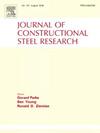Behaviour and design of square steel tubular slender columns at low temperatures
IF 4
2区 工程技术
Q1 CONSTRUCTION & BUILDING TECHNOLOGY
引用次数: 0
Abstract
The paper reported an experimental and numerical study on the low-temperature compression behaviour of square steel tube slender columns (SSTSCs). Thirteen SSTSCs were tested at low temperatures of 20, −30, −60, and − 80 °C. The SSTSCs with different slenderness ratios eventually failed in global buckling. The experimental results indicated that reducing the temperature from 20 °C to −80 °C improved the ultimate compressive capacity (PuT) of SSTSCs by over 10 %, but had marginal influence on the ductility (DI) and failure modes. The increasing slenderness ratio compromised the compression behaviours of SSTSCs with the reduced PuT and DI ratios. The established finite element models (FEMs) were validated by 13 SSTSCs test results at low temperatures. After validations, additional 104 FE results were obtained by a more extensive parametric study, e.g., low temperatures, slenderness ratios and width-to-thickness radios. Moreover, the applicability of the design curves in Eurocode 3, AISC 360–16 and GB50017 for SSTSC prediction was checked by these experimental and FE results, with prediction-to-test ratios of 0.90, 0.99 and 0.88, respectively. Validations indicated that three different codes could provide reliable and slightly conservative predictions on the PuT under low-temperature compression
方钢管细长柱在低温下的性能与设计
本文对方钢管细长柱的低温压缩性能进行了试验和数值研究。13种SSTSCs分别在20、- 30、- 60和- 80℃低温下进行测试。不同长细比的SSTSCs最终在整体屈曲中失效。试验结果表明,当温度从20℃降低到- 80℃时,SSTSCs的极限抗压能力(PuT)提高了10%以上,但对延性(DI)和破坏模式的影响微乎其微。长细比的增加降低了SSTSCs的压缩性能,降低了PuT和DI比。建立的有限元模型(fem)通过13个SSTSCs低温试验结果进行验证。验证后,通过更广泛的参数研究(如低温、长细比和宽厚比)获得了额外的104个FE结果。通过试验和有限元结果验证了欧洲规范3、AISC 360-16和GB50017中设计曲线对SSTSC预测的适用性,预测与试验比分别为0.90、0.99和0.88。验证表明,三种不同的编码对低温压缩下的PuT均能提供可靠且略保守的预测
本文章由计算机程序翻译,如有差异,请以英文原文为准。
求助全文
约1分钟内获得全文
求助全文
来源期刊

Journal of Constructional Steel Research
工程技术-工程:土木
CiteScore
7.90
自引率
19.50%
发文量
550
审稿时长
46 days
期刊介绍:
The Journal of Constructional Steel Research provides an international forum for the presentation and discussion of the latest developments in structural steel research and their applications. It is aimed not only at researchers but also at those likely to be most affected by research results, i.e. designers and fabricators. Original papers of a high standard dealing with all aspects of steel research including theoretical and experimental research on elements, assemblages, connection and material properties are considered for publication.
 求助内容:
求助内容: 应助结果提醒方式:
应助结果提醒方式:


